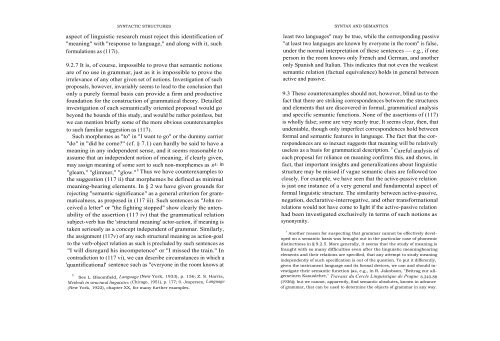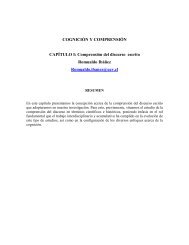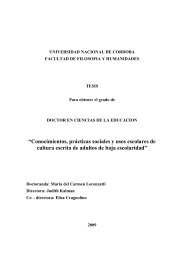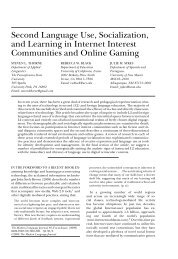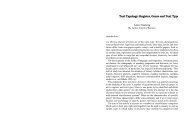Syntactic Structures
Syntactic Structures
Syntactic Structures
Create successful ePaper yourself
Turn your PDF publications into a flip-book with our unique Google optimized e-Paper software.
SYNTACTIC STRUCTURES<br />
aspect of linguistic research must reject this identification of<br />
"meaning" with "response to language," and along with it, such<br />
formulations as (117i).<br />
9.2.7 It is, of course, impossible to prove that semantic notions<br />
are of no use in grammar, just as it is impossible to prove the<br />
irrelevance of any other given set of notions. Investigation of such<br />
proposals, however, invariably seems to lead to the conclusion that<br />
only a purely formal basis can provide a firm and productive<br />
foundation for the construction of grammatical theory. Detailed<br />
investigation of each semantically oriented proposal would go<br />
beyond the bounds of this study, and would be rather pointless, but<br />
we can mention briefly some of the more obvious counterexamples<br />
to such familiar suggestion as (117).<br />
Such morphemes as "to" in "I want to go" or the dummy carrier<br />
"do" in "did he come?" (cf. § 7.1) can hardly be said to have a<br />
meaning in any independent sense, and it seems reasonable to<br />
assume that an independent notion of meaning, if clearly given,<br />
may assign meaning of some sort to such non-morphemes as gl- in<br />
"gleam," "glimmer," "glow." 8 Thus we have counterexamples to<br />
the suggestion (117 ii) that morphemes be defined as minimal<br />
meaning-bearing elements. In § 2 we have given grounds for<br />
rejecting "semantic significance" as a general criterion for grammaticalness,<br />
as proposed in (117 iii). Such sentences as "John received<br />
a letter" or "the fighting stopped" show clearly the untenability<br />
of the assertion (117 iv) that the grammatical relation<br />
subject-verb has the 'structural meaning' actor-action, if meaning is<br />
taken seriously as a concept independent of grammar. Similarly,<br />
the assignment (117v) of any such structural meaning as action-goal<br />
to the verb-object relation as such is precluded by such sentences as<br />
"I will disregard his incompetence" or "I missed the train." In<br />
contradiction to (117 vi), we can describe circumstances in which a<br />
'quantificational' sentence such as "everyone in the room knows at<br />
8 See L. Bloomfield, Language (New York, 1933), p. 156; Z. S. Harris,<br />
Methods in structural linguistics (Chicago, 1951), p. 177; 0. Jespersen, Language<br />
( New York, 1922), chapter XX, for many further examples.<br />
SYNTAX AND SEMANTICS<br />
least two languages" may be true, while the corresponding passive<br />
"at least two languages are known by everyone in the room" is false,<br />
under the normal interpretation of these sentences — e.g., if one<br />
person in the room knows only French and German, and another<br />
only Spanish and Italian. This indicates that not even the weakest<br />
semantic relation (factual equivalence) holds in general between<br />
active and passive.<br />
9.3 These counterexamples should not, however, blind us to the<br />
fact that there are striking correspondences between the structures<br />
and elements that are discovered in formal, grammatical analysis<br />
and specific semantic functions. None of the assertions of (117)<br />
is wholly false; some are very nearly true. It seems clear, then, that<br />
undeniable, though only imperfect correspondences hold between<br />
formal and semantic features in language. The fact that the correspondences<br />
are so inexact suggests that meaning will be relatively<br />
useless as a basis for grammatical description. 9 Careful analysis of<br />
each proposal for reliance on meaning confirms this, and shows, in<br />
fact, that important insights and generalizations about linguistic<br />
structure may be missed if vague semantic clues are followed too<br />
closely. For example, we have seen that the active-passive relation<br />
is just one instance of a very general and fundamental aspect of<br />
formal linguistic structure. The similarity between active-passive,<br />
negation, declarative-interrogative, and other transformational<br />
relations would not have come to light if the active-passive relation<br />
had been investigated exclusively in terms of such notions as<br />
synonymity.<br />
° Another reason for suspecting that grammar cannot be effectively developed<br />
on a semantic basis was brought out in the particular case of phonemic<br />
distinctness in § 9.2.5. More generally, it seems that the study of meaning is<br />
fraught with so many difficulties even after the linguistic meaningbearing<br />
elements and their relations are specified, that any attempt to study meaning<br />
independently of such specification is out of the question. To put it differently,<br />
given the instrument language and its formal devices, we can and should investigate<br />
their semantic function (as, e.g., in R. Jakobson, "Beitrag zur allgemeinen<br />
Kasuslehre," Travaux du Cercle Linguistique de Prague 6.240-88<br />
(1936)); but we cannot, apparently, find semantic absolutes, known in advance<br />
of grammar, that can be used to determine the objects of grammar in any way.


